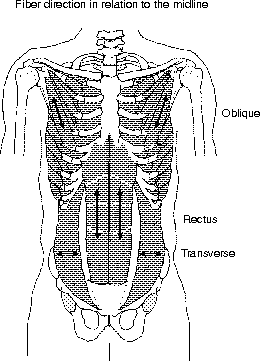Anatomy and Physiology: Fibers Every Which Way
Fibers Every Which Way
Muscles are sometimes named by virtue of the direction of the muscle fibers. There are only three angles that the muscle fibers can go when compared to the midline: parallel, perpendicular, and oblique. Abdominal muscles easily illustrate all three names. The term rectus means that the fibers are parallel; the rectus abdominus is, guess where, on the abdomen, and its fibers are parallel to the linea alba (which is on the midline). Just as in the section name, perpendicular fibers are called transverse; the transversus abdominus is a deep muscle with perpendicular fibers. Lastly, the external and internal obliques are both superficial to the transversus abdominus, but their fibers run at oblique angles (see Figure 9.4).

Figure 9.4The direction of the muscle fibers, which indicates the direction of the contraction, is referred to by the angle from the midline. (LifeART©1989-2001, Lippincott Williams & Wilkins)
Location, Location, Location
You will find that learning the bone names will be invaluable here. Since muscle attaches to bone, it makes a lot of sense to put the name of the bone it attaches to into the name of the muscle. There are too many examples to name them all here, and we already mentioned a couple before (tibialis anterior and flexor carpi ulnaris), so I'll just give you one more: The frontalis is attached to the frontal bone (you use it to raise your eyebrows).
Sometimes muscle names will use structures other than bones, such as the buccinator (buccal means mouth) attaching to the mouth. Another example is the levator labii superioris, which attaches to the lips (labii refers to lips). The last example also has within it another clue as to its location. If you were planning on looking under the mouth for the muscle, then you just aren't paying attention to the directional term superior!
You will often find a directional term, or a muscle movement, added to the bone name. Use this as a clue in remembering the muscle's location. The “dorsi” in latissimus dorsi tells you that the muscle is dorsal. You wouldn't look for the vastus lateralis on the medial side of the leg, but you would find it on the lateral side.
Remember the origin and the insertion? They can also find their way into muscle names. One example is the oddly named sternocleidomastoid. There are two origins on this muscle—the sternum (sterno) and the clavicle (cleido-)—and one insertion—the mastoid process of the temporal bone (mastoid).
Lights, Camera, Action!
Flex Your Muscles
Which is more important in terms of predicting a muscle's movement, its origin, or its insertion? Well, since the origin anchors the muscle to the unmoving bone, and the insertion attaches to the moving bone, I'd put my money on the insertion! Since muscle movements come in pairs, and antagonistic pairs perform them, be sure to pay close attention to which side of the bone the insertion is on, because the agonist and antagonists insertions will be on opposite sides.
Muscles are, after all, all about movements. As such, there are two things you should do when you are learning the muscles. The first thing is to look for any movement in the name, such as elevation in the levator scapulae. You should also know where to look for it, not only near the scapula, but superior to the scapula (in order to pull it up, after all). You can find plenty of examples, such as the flexor digitorum brevis in the foot, or the extensor carpi ulnaris.
The other thing to do is to pay attention to the muscle's location in order to figure out what movement the muscle produces. You will often be asked to know the movements of the muscles. If the movement is not given in the name, you have to problem solve, to use some logic, in order to figure it out. Take the gastrocnemius, which has its origin on the distal, posterior end of the femur, and its insertion on the posterior surface of the calcaneus bone by the calcaneal or Achilles tendon. What does the muscle do? If you said plantar flexion … good for you!
A Quick Look
The muscles in a college-level text are usually put into tables with five columns. The columns will include, in addition to the muscle name, the origin, the insertion, the muscle action (or movement), and the motor nerve that provides the stimulus for the muscle to contract (see The Structure of the Muscles and Muscle Cells). As I said earlier, it is not possible to include all that information in a section of this size, but hopefully what we have covered in this section will help you to crack those tables.

Figure 9.5The superficial muscles of the body, as seen from both anterior and posterior views. (LifeART©1989-2001, Lippincott Williams & Wilkins)
As you look at the diagrams of the muscles, see what you can interpret about the movements of the muscles from the name, and from the location. You should also see how many clues you can use to help you to remember the names of the muscles. As you are doing all this, think about how much you have already learned can help you to learn the muscles. Figure 9.5 shows the major superficial muscles.

Excerpted from The Complete Idiot's Guide to Anatomy and Physiology © 2004 by Michael J. Vieira Lazaroff. All rights reserved including the right of reproduction in whole or in part in any form. Used by arrangement with Alpha Books, a member of Penguin Group (USA) Inc.
To order this book direct from the publisher, visit the Penguin USA website or call 1-800-253-6476. You can also purchase this book at Amazon.com and Barnes & Noble.
